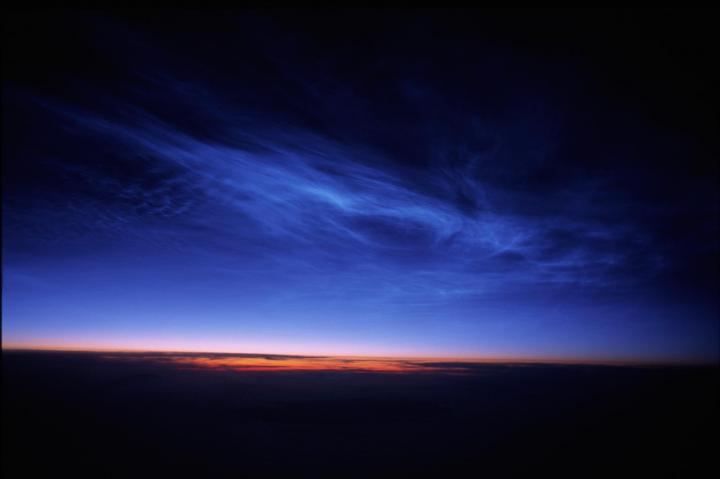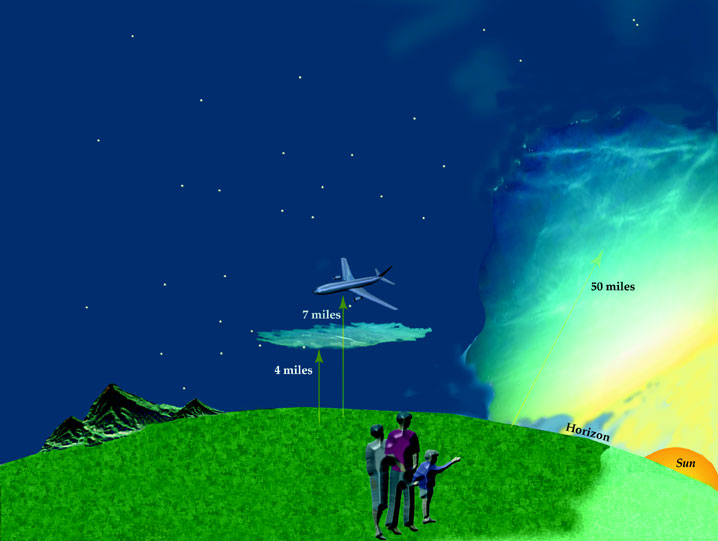It’s noctilucent cloud season! These “night-shining” clouds glow electric-blue when most of the sky has grown dark. Learn how to view summer’s noctilucent clouds!
What are noctilucent clouds?
If you look up and see ripples in gleaming silver and blue across the night sky, these are Earth’s highest clouds. They look alien—resembling something from another world. And that’s not far off. Would you believe: they are literally frosted meteor smoke formed by meteor dust! Yes, they come from outer space!
In the Northern Hemisphere, noctilucent clouds (NLCs) will appear in summer. Usually, noctilucent clouds are restricted to the most northern skies, but some years, they reach all the way to Middle America.
When meteors burn up in the upper atmosphere, they leave dust, like smoke. When the hot moist air of summer meets the cold dust from outer space, roughly 50 miles high in the atmosphere, clouds form. When the light from the rising or setting sun hits these sheets of icy smoke, it glows an eerie blue and seems to ripple like waves across the skies.
 Noctilucent Clouds seen from Alaska, 2006. Credit: NASA
Noctilucent Clouds seen from Alaska, 2006. Credit: NASA
More Facts About Noctilucent Clouds
- Noctilucent clouds or NLCs are Earth’s highest clouds in the sky, literally glowing at the edge of space in the atmosphere’s mesosphere layer, a high cold layer that is, according to NASA, “one hundred million times dryer than air from the Sahara desert.”
- They are the newest of all the clouds that we observe. They were first seen in 1885, after the famous explosion of Krakatoa volcano. The volcanic dust filtered out incoming sunlight, forming gorgeous fire-red sunsets. Watching sunsets became an international fad. Then, scientists noticed that after the sunset, mysterious glowing blue clouds began to spread through the skies.
- Strangely, even after Krakatoa’s volcanic debris settled, the clouds remained. Indeed they spread. Originally, they could only be seen in the most northern skies of Canada, Europe and Siberia. Now you can see them in the night skies of Colorado and Virginia. No one knows why they are spreading.

Image: The glowing clouds are formed when the light from the setting or rising sun strikes the icy clouds floating high in the atmosphere. Source: NASA and the Naval Research Laboratory, Washington, D.C.
More About How Noctilucent Clouds Form
Clouds are made of water and particles. In the lower atmosphere, water molecules attach to the dust in the air and form droplets. As these droplets float through the sky, too light to fall, they collect into clouds. Scientists were mystified. How could dust get fifty miles high into the air?
It was recent data from NASA’s AIM spacecraft that discovered this dust is from outer space. As meteors plunge into Earth’s atmosphere, they burn up. Only a few reach the surface of the Earth. The bits of “meteor smoke”, the microscopic dust, floats in the dry upper atmosphere, slowly collecting water molecules and forming ice crystals smaller than the particles in cigarette smoke.
They only form in summer, when hot moist air rises and a few, very few, water molecules rise high enough to cling to the drifting space dust. Then they form glittering sheets of ice, reflecting the lights of the setting sun with an eerie glittering blue light.

Noctilucent clouds as seen from space by astronauts aboard the International Space Station (ISS) in 2013.
The Krakatoa Volcano of 1885
The first time scientists ever record seeing noctilucent clouds was in 1885, after the famous explosion of Krakatoa volcano. The volcanic dust filtered out incoming sunlight, forming gorgeous fire-red sunsets. Watching sunsets became an international fad. Then, scientists noticed that after the sun set, mysterious glowing blue clouds began to spread through the skies.
Strangely, even after Krakatoa’s volcanic debris settled, the clouds remained. Indeed, they have spread south. Originally, they were seen only in the most northern skies of Canada, Europe and Siberia. Now you can see them in the night skies of Colorado and Virginia. No one knows why they are spreading.
How to View Noctilucent Clouds
Normally, you do need to live at a relatively high latitude on Earth to see them: between about 45° and 60° North or South latitude. In North America, this covers Canada plus the northern-tier Unites States including parts Washington, Oregon, Montana, Idaho, Minnesota, North Dakota, Michigan, Wisconsin, North Dakota, New York, Vermont, New Hampshire, and Maine. However, there have been years when these clouds will reach mid-America, particularly in days following the solstice.
From June through August, look towards the west 30 to 60 minutes after sunset. Noctilucent clouds are primarily visible when the sun is just below the horizon because the sunlight can still illuminate these high-altitude clouds, causing them to shine in the night sky. If you are lucky, you will see the rarest clouds on Earth. But even if you don’t live at these latitudes, it’s pretty cool to discover there are luminous blue-white clouds that come from outer space.
Learn more about basic types of clouds.


 Noctilucent Clouds seen from Alaska, 2006. Credit:
Noctilucent Clouds seen from Alaska, 2006. Credit: 








